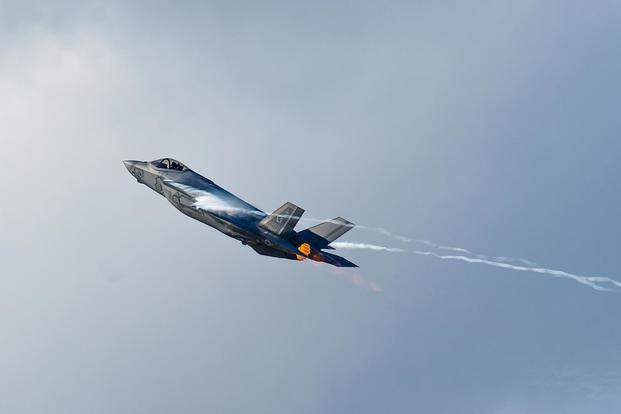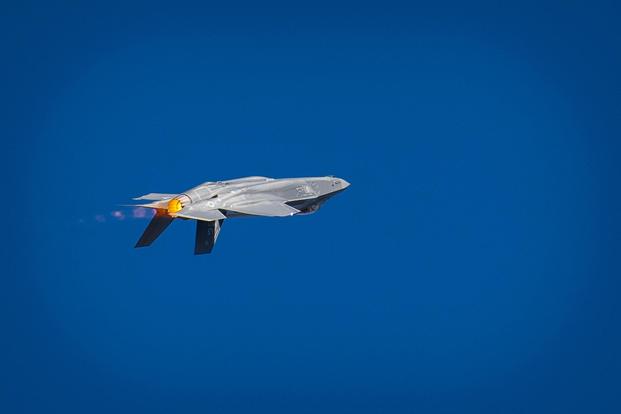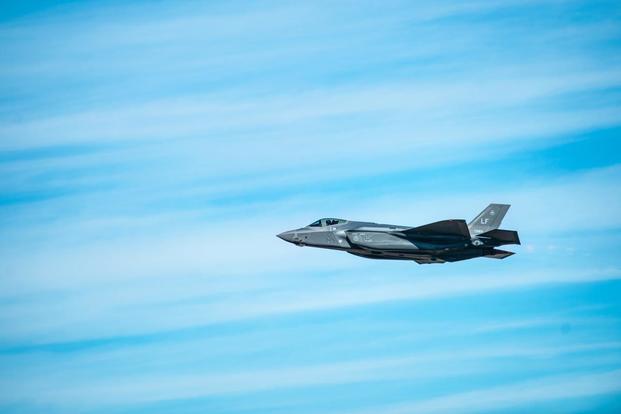Capt. Andrew "Dojo" Olson soared above RAF Fairford, England, piloting an F-35 Joint Strike Fighter during the Royal International Air Tattoo (RIAT) last July. It was the first time Olson had given aviation geek enthusiasts and skeptics alike a taste of maneuvers the fifth-generation stealth jet can perform at the world's largest military air show.
Now, Olson will be showing off those moves and more on tour.
"This show is going to solidify the F-35 in its rightful place, just [as] the absolute, cutting-edge stealth fighter jet [that's] here and it's ready and so capable," said Olson, an instructor pilot and commander of the F-35A Heritage Flight Team.
Military.com recently spoke with Olson, with the 56th Fighter Wing at Luke Air Force Base, Arizona, about the upcoming 2019 demonstration season, in which he will be the solo F-35 performer at 17 shows across the U.S. and Canada.
Related content:
- Peeking into the Air Force's F-35 Training Course
- Air Force: F-35 Buys Will Continue Regardless of Interest in F-15X
- Will the F-35 Be the Next Thunderbirds Jet?
"It's just a total, absolute rage fest within 15 minutes," Olson said.
The F-35 Lightning II has been part of the Heritage Flight for three seasons and is gearing up for its fourth starting this month, officials said. The Heritage Flight Foundation is a contractor with Air Combat Command and performs across the U.S. and overseas, flying old warbirds such as the P-51 Mustang.
Only four aircraft -- the A-10 Thunderbolt II, F-16 Fighting Falcon, F-22 Raptor and F-35 -- are certified to fly alongside the planes from a bygone era.
But this year is the first time the F-35 will have a breakout role in the 30-minute, full-narration air show, with its own 13-minute demo featuring state-of-the-art aerobatics.
"We're going out there to showcase the jet, [and] we're doing it fully aerobatic … fully showcasing the maneuvering envelope of the F-35," Olson said.
That means a minimum of 16 maneuvers, including rolls, loops, high-degree bank turns, and inverting to be fully upside down, among other actions. There will also be two new passes with the older warbirds, including a "fun bottom-up pass where the [audience] can see the bottom of the aircraft as it arcs over the crowd," he said.
Olson said the show pulls from the strengths and maneuvers of multiple airframes that came before the F-35. For example, the F/A-18 Super Hornet is "very impressive at a slow-speed capability, being able to do things like a square loop" and the F-16 Viper demo "is very fast and agile," he said. Audiences will be able to see the F-35 do both.
The F-35 "will be able to power out of other maneuvers" more swiftly because of its F135 engine, which propels it with more than 40,000 pounds of thrust, Olson said.
He will perform a pedal turn similar to the F-22, in which the F-35 banks and climbs high, eventually simulating a somersault-like move. But Olson will not use thrust vectoring or manipulate the direction of the engine's to control altitude or velocity.
"This is really just a testament to the design and the flight control logic that's built into the jet. And all these maneuvers are repeatable under all conditions … no matter what kind of temperature, or elevation, all these maneuvers are safe," Olson said.
"For the first three seasons, we wanted the public to see the F-35, but it wasn't fully ready," Olson said, meaning that not every jet used for demonstrations was configured to the latest Block 3F software. "The F-35 program involved concurrent production and test. … There was a little extra amount of testing still left to do … and software and hardware modifications."
That restricted pilots to a maximum of 7 G-forces, but now Olson can pull a full 9Gs if he wishes.
And he has: During the RIAT show in July, Olson climbed to a full 9G configuration because that specific jet was fully capable. But he said he still wasn't performing the high-banking maneuvers he now can for the upcoming season.
Olson and a small team at Luke have been working on the first-of-its-kind show since December. They traveled to manufacturer Lockheed Martin Corp.'s F-35 simulator facilities in Fort Worth, Texas, to develop the show alongside Billie Flynn, Lockheed's experimental test pilot.
The demo moves also simulate how the F-35 will perform in combat, Olson said.
"Through our narration, we attempt to succeed in connecting the maneuver at the air show to its real world, tactical application," he said, adding that he flies the F-35 like he's in a combat configuration but he won't be carrying an ordnance load.
Still, "you are seeing the jet and how it would perform in actual combat," he said.
As additional jets came to Luke for pilot training, it gave the demo team breathing room to practice because they weren't taking planes away from the primary training mission, Olson said.
The base now has 87 of the jets, with more than 90 percent configured to the Block 3F software.
"As far as flying operations go at Luke, [we now have enough] jets to support a demo team," said Olson, who was previously an F-15E Strike Eagle pilot.
The show routine has been flown more than 40 times. Each time, he and other pilots, maintainers, avionics specialists and others involved in the show watch the tape from the cockpit and another recorded from the ground to see what can be perfected.
"We grade ourselves down to the foot, and down to the knot of airspeed," Olson said. "When you travel at 1,000 feet per second, that's a tight tolerance. But that's the precision in which we designed this thing."
He added, "No one has seen the F-35s perform this way and I … think it really sets the bar for what a demo [show] can be."
Olson says he doesn't see additional F-35 jets being added to the demo, though maneuvers may be tweaked or added in future seasons.
"That work is never finished," he said. "Connecting the U.S. military, the U.S. Air Force with the American public is the goal. And the F-35 demonstration is the conduit for which we forge that connection."
-- Oriana Pawlyk can be reached at oriana.pawlyk@military.com. Follow her on Twitter at @Oriana0214.












